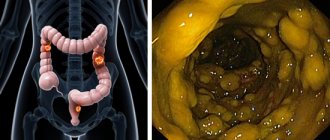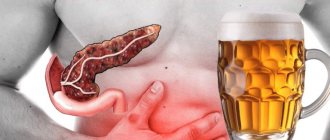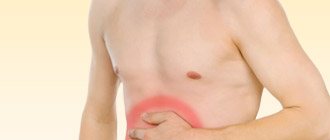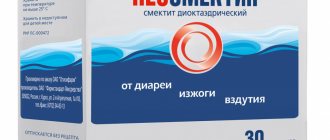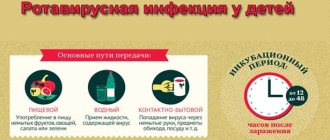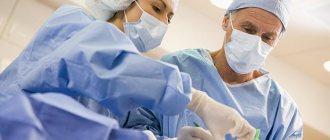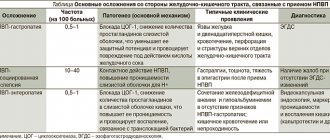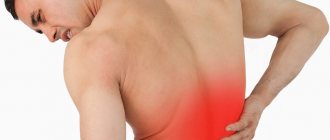Antibiotic-associated colitis, severe. Analysis of a clinical case
Authors of the clinical analysis:
Korneeva Olga Nikolaevna - Candidate of Medical Sciences, doctor at the clinic of propaedeutics of internal diseases, gastroenterology and hepatology of the First Moscow State Medical University named after I.M. Sechenov
Ivashkin Vladimir Trofimovich – Academician of the Russian Academy of Medical Sciences, Professor, Head of the Department of Propaedeutics of Internal Diseases and Director of the Clinic of Propaedeutics of Internal Diseases, Gastroenterology and Hepatology of the First Moscow State Medical University named after I.M. Sechenov.
An elderly 62-year-old man came to the clinic with complaints of loose stools up to 8 times a day, increased body temperature to 38-39C, spastic pain in the periumbilical region, general weakness and weight loss of 7 kg within a month.
From the anamnesis it is known that 20 days before admission he was treated in a district hospital for bronchopneumonia. Antibiotic therapy was carried out with a third generation cephalosporin. With treatment, the pneumonia resolved and the patient was discharged in satisfactory condition. 3 days after finishing taking the antibiotic, he noted the appearance of frequent watery stools and general weakness. The patient independently began taking chloramphenicol and loperamide. After which there was a sharp deterioration in the condition - a fever of up to 39C with chills, severe general weakness, and diarrhea persisted. The patient consulted a doctor at the clinic, where a stool examination was recommended to exclude intestinal infections. Examination of stool for a disgroup of pathogens of intestinal infections did not reveal. Due to the persistence of the above complaints, the patient was hospitalized in our clinic.
On objective examination , the condition is moderate, 38C, the skin and visible mucous membranes are pale, the tongue is dry, the abdomen is enlarged due to flatulence, and on palpation it is moderately painful along the colon.
It was necessary to establish a preliminary diagnosis. Negative results of a stool test for disgroup cast doubt on the presence of an intestinal infection; the onset of inflammatory bowel disease in a 62-year-old man seemed unlikely. The existing risk factors for antibiotic-associated colitis - taking antibiotics, old age, the presence of concomitant pathology (coronary heart disease, hypertension) indicated with a high probability the presence of antibiotic-associated colitis, severe (pseudomembranous?).
An examination was started. In blood tests, attention was drawn to normochromic iron deficiency anemia, leukocytosis with a shift of the leukocyte formula to the left up to myelocytes, thrombocytosis and acceleration of ESR. Hyponatremia, hypoalbuminemia, decreased iron levels, a sharp increase in C-reactive protein levels, and a positive fecal occult blood reaction with benzidine were also detected. When examining stool using ELISA, C. difficile toxins A and B were detected. To exclude dilatation of the colon, a survey photograph of the abdominal cavity was taken in the supine position - the width of the loops was within normal limits. An ultrasound examination of the abdominal cavity revealed thickening of the walls of the colon up to 10 mm. Thickening of the walls of the colon and narrowing of the intestinal lumen were also noted on computed tomography of the abdominal organs.
During sigmoidoscopy: the device is inserted into the sigmoid colon, in the examined areas the mucous membrane is moderately hyperemic, with multiple whitish inclusions. The rectal mucosa is hyperemic and edematous. Conclusion: antibiotic-associated colitis (pseudomembranous). (Fig. 2).
Rice. 2. Sigmoidoscopy
The morphological picture corresponded to pseudomembranous colitis: necrosis of the epithelium, fibrin effusion with neutrophils, typical ulcerations of the mucous membrane reminiscent of volcanic eruptions, and the formation of pseudomembranes were detected (Fig. 3).
Rice. 3. Morphological picture of pseudomembranous colitis
Thus, the following clinical diagnosis was established: Antibiotic-associated colitis, severe (pseudomembranous). Malabsorption syndrome: iron deficiency anemia. Hypoalbuminemia.
Treatment of the patient included rehydration therapy, parenteral nutrition, with further transfer to enteral nutrition, metronidazole 500 mg IV every 6 hours, vancomycin 250 mg 4 times a day. Probiotic drugs were not prescribed. During treatment, the patient's condition improved, body temperature normalized, stool frequency and general weakness gradually decreased, the patient gained weight and was discharged in satisfactory condition.
2 weeks after discharge from the hospital, the patient was prescribed antibiotic therapy after tooth extraction, which was interrupted on the 2nd day due to the occurrence of diarrhea. The patient came to our clinic. A recurrence of C. difficile -associated colitis was suspected, which was confirmed by the detection of C. difficile toxins in the stool. Vancomycin therapy was prescribed at an initial dose of 500 mg 2 times a day, followed by a gradual dose reduction in combination with the probiotic drug Florasan A, 1 capsule 3 times a day for 14 days. The patient's condition quickly improved; no relapses of diarrhea were observed during 1 year of observation.
Probiotic preparations (Florasan A) have a clear effect in the treatment of antibiotic-associated colitis, which makes the inclusion of probiotics in treatment regimens relevant. Important elements for the prevention of antibiotic-associated intestinal lesions are the differentiated prescription of antibiotics under the strict and mandatory supervision of a doctor, as well as the mandatory prescription of probiotics simultaneously with the start of antibacterial therapy.
Probiotics and antibiotic-associated diarrhea: what's new?
1. Khavkin A.I. Antibiotic-associated diarrhea: possibilities of using probiotics // Difficult patient. – 2022. – No. 1-2 (16). – P. 48-52.
2. Kryukov E.V., Popova T.N., Parinov O.V., Meshkov V.V. Antibiotic-associated conditions in the practice of a gastroenterologist at a multidisciplinary medical institution // Infectious diseases: news, opinions, training. - 2022. - No. 6. - P. 79–84.
3. Makins R., Ballinger A. Gastrointestinal side effects of drugs // Expert Opin Drug Saf. – 2003. – No. 2 (4). – R. 421-429. DOI:10.1517/14740338.2.4.421.
4. Giannelli FR Antibiotic-associated diarrhea // JAAPA. – 2017 – No. 30 (10). – R. 46–47. doi: 10.1097/01. JAA.0000524721.01579.c9.
5. Kanner E.V. et al. What methods of prevention and treatment of antibiotic-associated diarrhea in children currently exist? // Medical advice. – 2022. – No. 1. – P. 177-184.
6. Kuijper EJ, Coignard B., Tüll P. Emergence of Clostridium difficile-associated disease in North America and Europe // Clinical Microbiology and Infection. – 2006. – No. 12 (suppl. 6). R. 2-18. oi.org/10.1111/j.1469-0691. 2006.01580.x
7. Hickson M. Probiotics in the prevention of antibiotic-associated diarrhoea and Clostridium difficile infection // Therap Adv Gastroenterol. – 2011. – No. 4 (3). – R. 185–197. DOI: 10.1177/1756283X11399115.
8. Zakharenko S. M., Andreeva I. V., Stetsyuk O. U. Adverse drug reactions from the gastrointestinal tract and antibiotic-associated diarrhea when using antibiotics in outpatient practice: prevention and treatment // Clinical microbiology and antimicrobial chemotherapy. – 2022. – No. 21 (3). – pp. 196–206.
9. Högenauer C., Hammer HF, Krejs GJ, Reisinger EC Mechanisms and management of antibiotic-associated diarrhea // Clin Infect Dis. – 1998. – No. 27 (4). – R. 702-710. DOI: 10.1086/514958.
10. Jernberg C., Lofmark S., Edlund C., Jansson JK Long-term ecological impacts of antibiotic administration on the human intestinal microbiota // ISME J. - 2007. - No. 1. - R. 56-66. DOI: 10.1038/ismej.2007.3.
11. Sjölund M., Tano E., Blaser MJ, Andersson DI, Engstrand L. Persistence of resistant Staphylococcus epidermidis after single course of clarithromycin // Emerg Infect Dis. – 2005. – No. 11. – R. 1389-1393. DOI: 10.3201/eid1109.050124.
12. Löfmark S., Jernberg C., Jansson JK, Edlund C. Clindamycin-induced enrichment and longterm persistence of resistant Bacteroides spp. and resistance genes // J Antimicrob Chemother. – 2006. – No. 58. – R. 1160-1167. DOI: 10.1093/jac/dkl420.
13. Dethlefsen L., Huse S., Sogin ML, Relman DA The Pervasive Effects of an Antibiotic on the Human Gut Microbiota, as Revealed by Deep 16S rRNA Sequencing // PLoS Biol. 2008. -No. 6 (11). – R. 2383-2400. DOI: 10.1371/journal.pbio.0060280.
14. Ivashkin V. T., Yushchuk N. D., Maev I. V., et al. Recommendations of the Russian Gastroenterological Association for the diagnosis and treatment of Clostridium difficile-associated disease // Russian Journal of Gastroenterology, Hepatology, Coloproctology. – 2016. – No. 5 (26). – pp. 56–65.
15. Szajewska H., Canani RB, Guarino A., Hojsak I., et al. ESPGHAN Working Group for Probiotics and Prebiotics. Probiotics for the prevention of antibiotic-associated diarrhea in children // J Pediatr Gastroenterol Nutr. – 2016. – No. 62 (3). – R. 495–506. doi: 10.1097/MPG.0000000000001081.
16. Surawicz CM, Brandt LJ, Binion DG, Ananthakrishnan AN, et al. Guidelines for diagnosis, treatment and prevention of Clostridium difficile infections // Am J Gastroenterol. – 2013. – No. 108 (4). – R. 478–498. doi:10.1038/ajg.2013.4.
17. Shelygin Yu. A., Alyoshkin V. A., Sukhina M. A. et al. Clinical recommendations of the National Association of Specialists for the Control of Infections Associated with the Provision of Medical Care and the All-Russian Public Non-Profit Organization “Association of Coloproctologists of Russia” for diagnostics, treatment and prevention of Clostridium difficile-associated diarrhea (CDI). - M. - 2022. - 24 p. — [URL]: https://www.gnck.ru/rec/recommendation_clostridium_difficile.pdf (accessed December 25, 2020).
18. Pogozheva A. V., Sheveleva S. A., Markova Yu. M. The role of probiotics in the nutrition of healthy and sick people // Attending physician. – 2022. – No. 5. – P. 67-75.
19. Shen NT, Maw A., Tmanova LL, Pino A., Ancy K., Crawford CV, et al. Timely Use of Probiotics in Hospitalized Adults Prevents Clostridium difficile Infection: A Systematic Review With Meta-Regression Analysis // Gastroenterology. 2017; 152(8): 1889-1900. DOI: 10.1053/j.gastro.2017.02.003.
20. Wanqian Liao et al. Probiotics for the Prevention of Antibiotic-Associated Diarrhea in Adults. A Meta-Analysis of Randomized Placebo-Controlled Trials // J Clin Gastroenterol. — 2020. — [URL]: DOI: 10.1097 / MCG.0000000000001464 (access date 12/25/2020).
21. Qin Guo. et al. Probiotics for the prevention of pediatric antibiotic-associated diarrhea // Cochrane Database Syst Rev. – 2019. – 4 (4). - CD004827. DOI: 10.1002/14651858.CD004827.pub5.
22. Probiotics and prebiotics. World Gastroenterology Organization Global Guidelines. - 2022. - [URL]: https://www.worldgastroenterology.org/UserFiles/file/guidelines/probiotics-and-prebiotics-russian-2017.pdf (access date 12/25/2020).
23. Goldenberg JZ et al. Probiotics for the prevention of Clostridium difficile-associated diarrhea in adults and children // Cochrane Database Syst Rev. – 2022. – 12 (12). - CD006095. doi: 10.1002/14651858.CD006095.pub4.
24. Kaibysheva V. O., Nikonov E. L. Probiotics from the position of evidence-based medicine // Evidence-based gastroenterology. – 2022. – No. 8 (3). – P. 45-54.
25. Yue Y. et al. Lactobacillus plantarum relieves diarrhea caused by enterotoxin-producing Escherichia coli through inflammation modulation and gut microbiota regulation // Food Funct. – 2022. – No. 11 (12). – R. 10362–10374. doi: 10.1039/d0fo02670k.
26. McFarland LV Probiotics for the Primary and Secondary Prevention of C. difficile Infections: A Meta-analysis and Systematic Review // Antibiotics (Basel). – 2015. – No. 4 (2). - R. 160-178. DOI: 10.3390/antibiotics4020160.
27. Aloisio I. et al. Characterization of Bifidobacterium spp. strains for the treatment of enteric disorders in newborns // Appl Microbiol Biotechnol. – 2012. – No. 96 (6). – R. 1561-1576. DOI: 10.1007/s00253-012-4138-5.
28. Valdés-Varela L. et.al. Effect of Bifidobacterium upon Clostridium difficile Growth and Toxicity When Co-cultured in Different Prebiotic Substrates // Front Microbiol. – 2016. – No. 7. – R. 738. DOI: 10.3389 / fmicb.2016.00738.
29. Ojima MN et al. Bifidobacterium bifidum Suppresses Gut Inflammation Caused by Repeated Antibiotic Disturbance Without Recovering Gut Microbiome Diversity in Mice // Front. Microbiol. – 2020. – [URL]: https://doi.org/10.3389/fmicb.2020.01349 (accessed December 25, 2020).
30. Corrêa NBO et al. A randomized formula controlled trial of Bifidobacterium lactis and Streptococcus thermophilus for prevention of antibiotic-associated diarrhea in infants // J Clin Gastroenterol. – 2005. – No. 39 (5). – R. 385-389. DOI: 10.1097/01.mcg.0000159217.47419.5b.
31. Kolling GL et al. Lactic acid production by Streptococcus thermophilus alters Clostridium difficile infection and in vitro Toxin A production // Gut Microbes. – 2012. – No. 3 (6). – R. 523-529. doi: 10.4161/gmic.21757. Epub 2012 Aug 16.
32. Mahmud ASM et al. In-vivo evaluation of the anti-diarrheal effect of Lactococcus lactis subspecies lactis and Lactococcus piscium isolated from yogurt. — [URL]: https://doi.org/10.1101/2020.07.30.226688 (accessed 12/25/2020).
33. Ivashkin V. T., Poluektova E. A et al. Practical recommendations of the Scientific Community for Promoting the Clinical Study of the Human Microbiome (NSOM) and the Russian Gastroenterological Association (RGA) on the use of probiotics for the treatment and prevention of gastroenterological diseases in adults. — 2022. — [URL]: https://www.gastro-j.ru/jour/article/view/ 478?locale= ru_RU (access date 12/25/2020).
34. Millette M., Nguyen A., Amine KM, Lacroix M. Gastrointestinal survival of bacteria in commercial probiotic products // International Journal of Probiotics and Prebiotics. – 2013. – No. 8 (4). – R. 149-156. — [URL]: https://www.researchgate.net/publication/285929818 (accessed 12/25/2020).
35. Plotnikova E. Yu., Zakharova Yu. V. The place of probiotics in modern clinical practice // Consilium Medicum. Pediatrics. – 2018. – No. 1. – P. 30–34.
36. Kareva E.. N. NSAID enteropathy - prospects for prevention and treatment // Breast cancer. - 2022. - No. 7. - P. 11-14.
37. Klare I., Konstabel C., Werner G., et al. Antimicrobial susceptibilities of Lactobacillus, Pediococcus and Lactococcus human isolates and cultures intended for probiotic or nutritional use // J.of Antimicrob. Chemotherapy. – 2007. – No. 5. – R. 900-912. DOI: 10.1093/JAC/DKM035.
38. Guidelines on the assessment of bacterial susceptibility to antimicrobials of human or veterinary importance // The EFSA J. – 2012. – No. 10. – P. 2740–2750. — [URL]: https://www.efsa.europa.eu/en/efsajournal/ pub/2740 (accessed 12/25/2020).
